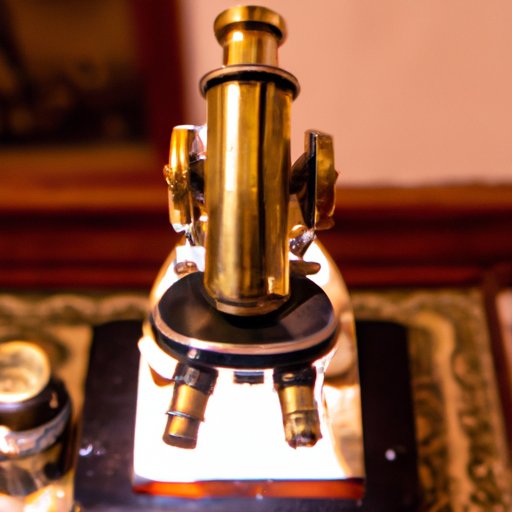Introduction
A microscope is a device used to magnify objects that are too small to be seen with the naked eye. It is an essential tool in many areas of science such as biology, chemistry, and medicine. The invention of the microscope revolutionized science forever, allowing us to study the world around us on a much smaller scale than ever before.
The purpose of this article is to explore the history of the microscope and its inventor. We will look at who invented the microscope, why it was such an important invention, and how it has impacted science over the years.
Historical Overview of the Inventor of the Microscope
The invention of the microscope is credited to Dutch spectacle makers Hans and Zacharias Janssen. The father-son duo is believed to have created the first compound microscope in 1590. The microscope consisted of two lenses mounted inside a tube, which allowed for a magnified image to be viewed through the eyepiece. Although the design was rudimentary, it was the first of its kind and paved the way for future advancements in microscopy.
At the time of its invention, the microscope opened up a whole new world of exploration. Scientists were able to observe things they had never seen before, such as cells and microorganisms. This newfound ability allowed them to make groundbreaking discoveries in the fields of biology, medicine, and chemistry.

Biography of the Person Who Invented the Microscope
Hans and Zacharias Janssen were both Dutch spectacle makers from Middelburg, Holland. They are credited with inventing the first compound microscope in 1590. The microscope was made from two lenses mounted inside a tube, which allowed for a magnified view of the object being observed.
Little is known about their motivations for inventing the microscope, but it is believed that they were curious people who wanted to explore the world around them. Their curiosity led them to create a device that would revolutionize science and open up a whole new realm of exploration.

Timeline of the Invention of the Microscope
The invention of the microscope is credited to Hans and Zacharias Janssen in 1590. However, the invention process was a long and arduous one. It took centuries of trial and error before the microscope we know today was perfected.
In 1665, English scientist Robert Hooke published his famous book “Micrographia”, which detailed his observations using a microscope. He was the first to use the term “cell” when describing the structures he observed under the microscope. This was a major breakthrough in biology and opened up the field of cell biology.
In the 18th century, Antonie van Leeuwenhoek improved upon the design of the microscope by adding a stronger lens and a better light source. This allowed him to observe even smaller organisms such as bacteria and protists. His work laid the foundation for modern microscopy.
In the 19th century, Ernst Abbe developed the Abbe condenser, which allowed for greater contrast and resolution in the images produced by the microscope. This was a major step forward in the development of the microscope and allowed scientists to observe even more intricate details.
Comparison Between the Original Microscope and Today’s Models
Today’s microscopes are vastly different from the original model invented by Hans and Zacharias Janssen. Modern microscopes are far more sophisticated, with higher magnification capabilities and better resolution. They also have many features such as digital cameras, video capabilities, and computer software.
One of the most significant advances in microscopy has been the development of the electron microscope. This type of microscope uses a beam of electrons instead of light to produce an image. This allows for much higher magnification and resolution than traditional microscopes, allowing scientists to observe even smaller structures such as proteins and viruses.

How the Microscope Revolutionized Science
The invention of the microscope has revolutionized the scientific world. It has enabled scientists to observe things they could never see before, such as cells and microorganisms. This newfound knowledge has allowed them to make groundbreaking discoveries in the fields of biology, medicine, and chemistry.
The microscope has also opened up new avenues of research. For example, researchers can now study the effects of drugs on cells or observe the behavior of viruses. This has allowed for a deeper understanding of the natural world and has enabled us to develop treatments for a variety of diseases.
Finally, the microscope has allowed us to explore our own bodies. Medical professionals can now examine tissue samples under the microscope to diagnose illnesses or detect cancer. This has revolutionized the practice of medicine and has improved the lives of millions of people around the world.
Conclusion
The invention of the microscope revolutionized science forever. It allowed us to observe things we could never see before and opened up a whole new realm of exploration. The invention of the microscope is credited to Dutch spectacle makers Hans and Zacharias Janssen, and it has since been improved upon by numerous other scientists throughout history.
Today, the microscope is an essential tool in many areas of science. It has allowed us to make groundbreaking discoveries in the fields of biology, medicine, and chemistry, and it has enabled us to explore our own bodies in new and innovative ways. The microscope has truly changed the world and will continue to do so for years to come.
(Note: Is this article not meeting your expectations? Do you have knowledge or insights to share? Unlock new opportunities and expand your reach by joining our authors team. Click Registration to join us and share your expertise with our readers.)
